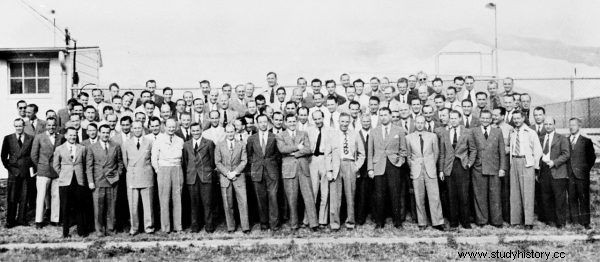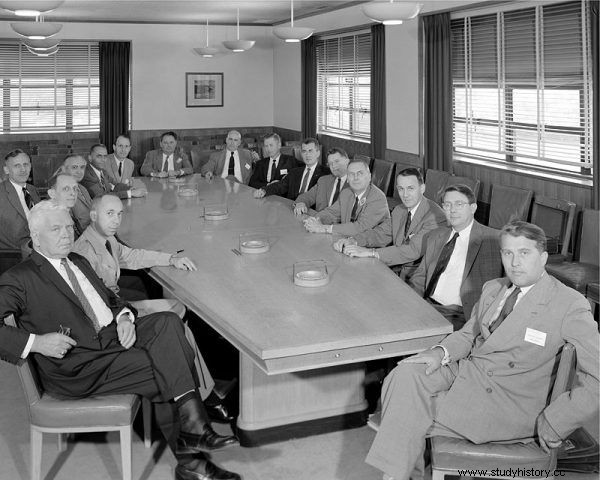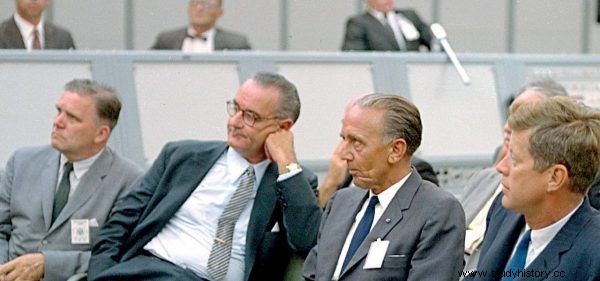Winning a war usually means a lot of loot for the winners. It was no different when the Allies defeated the Axis powers in 1945. Almost immediately, they began to distribute the territories and resources of the losing countries. For the Americans, however, the greatest war gain turned out to be ... scientists working for Hitler.
The last months of the Second World War marked the beginning of a new clash on the international arena. Even then - before the war ended - the capitalist states began to compete with the growing communist movement. The fight was, inter alia, for human resources, and strictly speaking - scientists of the Third Reich.
The American military elite was greatly impressed by German armaments research. From the end of 1944, the Bureau of Strategic Services (OSS) conducted an action called "Overcast", which assumed taking over the scientific potential of Germany and Japan. After the surrender of Tokyo, the action was renamed "Paperclip" or "Paperclip".
The American public found out about the case months later. As in the book Chasing the Moon. The nation, the politicians and the promise that took the US into the space age ” by Robert L Stone and Alan Anders:
Operation Paperclip was first mentioned publicly in a slender War Department release on October 1, 1945. He announced that a carefully selected group of "eminent German scientists" would be brought to the US to share the technical knowledge necessary for national security . The one-page message also stated that Germany would be in the United States temporarily and all volunteered.
American pragmatism
The assumptions of Operation Paperclip were quite realistic. Already in the first months of 1944, the American intelligence services gained a lot of knowledge about the military capabilities of the Germans. Particular attention was paid to the development of a project to build a long-range V2 rocket and to research in the field of medicine.

Many Nazi rocket scientists went to Fort Bliss, Texas.
The American military circles were convinced that in order to implement their own defense strategy, it was necessary to bring in the right people. How the German scientists came to any specific conclusions was not asked. What mattered was the effect; It was also expected that the scientists brought back to the country would be able to help in the fight against world communism. This is confirmed by the American journalist Eric Lichtblau:
Thousands of Nazis slipped across borders without anyone's support, easily deceiving the US immigration system. Many of them received help, including from senior military and intelligence officials in the Pentagon, the CIA and other agencies, who believed that new immigrants, despite their obvious ties to Nazism, or perhaps thanks to them, could help overcome the threat posed by the Union. Soviet. Officials in Washington liked to say that it was hard to find someone who hated the Soviets more than the Nazis - and wanted to take advantage of that hostility .
The so-called 'DPs' were best known to the pragmatism of the new American strategy (short for displaced persons ), i.e. people deported to forced labor. It was a group of several million people, often sick and without a clear state status. It would seem that after the end of the war, the closure of crematoria and labor camps, the organization of their return home should be a priority.
The Allies, however, were ruthless. They decided to keep the "liberated" workers in the places of execution. They were more interested in ... their torturers who experimented with people or created weapons thanks to the inhuman work of prisoners . They were transported to safe territories. As the authors of the book explain, “Chasing the Moon. The nation, the politicians and the promise that took the US into the space age ” :
The War Department and the OSS considered German scientists and engineers such a valuable gain that they were far more concerned with accessing their knowledge than dealing with controversial (and deeply hidden) details with acts of war.
Stalin's control of Eastern Europe raised fears of another long conflict, and shortly after the war, Americans suspected of having communist sympathies were considered a much greater threat than those associated with the past with the defeated Third Reich .
The end justifies the means
The US administration first provided appropriate working conditions for the team led by Wernher von Braun. This designer, visionary and Nazi was responsible for the project to build the V1 and V2 rockets. He managed to create a weapon that was able to carry payloads over long distances, including in Belgium and England.
The Western Allies knew from 1943 about the secret missile research center in Peenemünde (Usedom Island), where thousands of forced prisoners worked until the end of the war. Von Braun gave up running the project as Allied troops grew closer to Berlin. He escaped with a group of trusted engineers to Bavaria, where he turned himself over to the Americans.
The scientist had no problems establishing himself in the United States as a young genius of aristocratic origin. The American services helped him a lot in this. As emphasized by Robert L Stone and Alan Anders:
The Washington Joint Intelligence Objectives Agency (JIOA) carefully whitened (...) the troubling biographies of von Braun and other participants in "Paperclip" reminiscent of Hollywood columnists producing fake acting resumes in the studio system.

In 1958, when the above photo of the NASA special committee was taken, few people remembered about von Braun's criminal past (first from right).
This was done so effectively that Wernher von Braun became a television star in the post-war period. For several decades, for many young Americans he was the "father" of NASA and the space programs. It was only in the 1970s that he was recognized and accused by former prisoners of involvement in war crimes. However, he never stood trial. He only had to explain his involvement in research for the Third Reich.
The fate of another Nazi researcher who transferred his activities to the United States - Hubertus Strughold, was slightly different. During the war he was a doctor in Dachau, where he made experiments on people. Among other things, he tested reactions to low temperatures or simulated falls from great heights.
This research was later used in the design of the first spaceflight . Strughold itself has been honored and awarded for years. In the years 1963-2012, the Society of Aviation Medicine even awarded an award named after him! Only in 2013, further proceedings were suspended. Not long before that, the name of the "scientist" began to be erased from the chronicles of research institutions.
Needed elsewhere
During the action, the American administration used every possible way to convince citizens that German researchers would act for the benefit of the state. The New York Times reported in 1946 that the involvement of Nazi scientists would save as much as $ 750 million .
Few people objected to the policy of admitting German "refugees". Among them were Albert Einstein and former First Lady Eleanor Roosevelt. With each passing week, however, the propaganda machine grew stronger, and the fear of Soviet domination seemed to justify any move by the authorities.

One of the scientists brought to America was Kurt H. Debus. In the photo he is sitting between President John F. Kennedy and Vice President Lyndon Johnson.
In total, the intelligence services organized and received nearly 1,600 people from German laboratories. They conducted a number of studies, the effects of which we use until today. Some, like von Braun, were involved in the conquest of space, others, for example, in the field of chemistry and agriculture.
There is no doubt that the actions of the Americans were a common strategy after the war. The Russians also detained selected scientists. Operation "Paperclip" sheds a slightly different light, for example, on the Nuremberg trials themselves. Decision-makers were placed on the defendants' bench, but there weren't enough of those who created the means of extermination . Why? Today we know that they were needed elsewhere.
